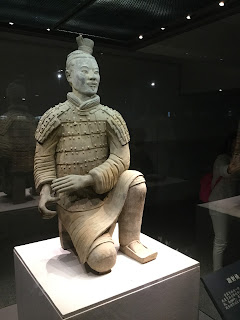Xi'an City Wall was erected in the 14th century Ming Dynasty, under the regime of Emperor Zhu Yuanzhang. When Zhu Yuanzhang captured Huizhou, long before the establishment of the Ming Dynasty, he was admonished by a hermit named Zhu Sheng, who told him to "build high walls, store abundant provisions and take your time in proclaiming yourself emperor", advice heeded by Zhu Yuanzhang. The current city wall is an enhancement of the old Tang Dynasty structure, as a result of the emperor's wall building campaign.
There is a flanking tower every 120 meters. The flanking towers were built to allow soldiers to see enemies trying to climb the wall. The distance between the flanking towers is within the range of arrows fired from either side. This allowed soldiers to protect the entire wall without exposing themselves to the enemy. There are 98 flanking towers; each has a sentry building on top of it.
Our next stop was the Terracotta Workshop
where they make souvenirs including life size terracotta warrior figures in the traditional way the originals were made, which you can purchase and have shipped to your home.
Finally it was time to go to see the Terracotta Army itself, the highlight of the holiday for me. I cannot even begin to describe what it was like except to say WOW, so I will let the photographs speak for themselves.
The floors were rammed with earth 45cm thick and paved with bricks.
The site has no-where near all been excavated.
There are even horses!
It is said that all the warriors have a different face and their ranks are shown by the different hairstyles.. This next photograph shows that it could quite possibly be true, you will see the differences if you click on the photo for a closer look.
There is a space at the back of the dig where figures are renovated to be put back where they were found.
In the museum you can see the different ranks explained. A kneeling archer.
Middle ranking officer.
High ranking officer.
Cavalryman with his saddled horse.
Standing archer.
The bronze chariot and horses that were found are in the museum.
The Terracotta Army is part of a much larger necropolis. The entire necropolis built for the emperor covering a large area was found surrounding the first emperor's tomb mound. The earthen tomb mound is located at the foot of Mount Li and built in a pyramidal shape with Qin Shi Huang’s necropolis complex constructed as a microcosm of his imperial palace or compound. The warriors stood guard to the east of the tomb.
The tomb appears to be a hermetically-sealed space the size of a football pitch.The tomb remains unopened, possibly due to concerns about preservation of its artifacts. After the excavation of the Terracotta Army, the painted surface present on some terracotta figures began to flake and fade.The lacquer covering the paint can curl in fifteen seconds once exposed to Xi'an's dry air and can flake off in just four minutes.
We were told by our guide that archeologists and scientists are working hard to find a way to open the tomb without destroying what is in it. We have always said we never go back anywhere because there is so much to see in the world. However, if that tomb is opened and available to see in our lifetime we intend to try our hardest to go to see it.
We have lots more photos, this is just a small selection, and the most wonderful memories of actually seeing something most people can only dream of. Suffice to say it was A.M.A.Z.I.N.G.!
I hope you've enjoyed seeing the famous Terracotta Army and I do hope you will get to see it for yourself some day.
Please join me for Part 10 when we continue our journey to Beijjing.












































































